Between the Lines - Reflections at the intersections
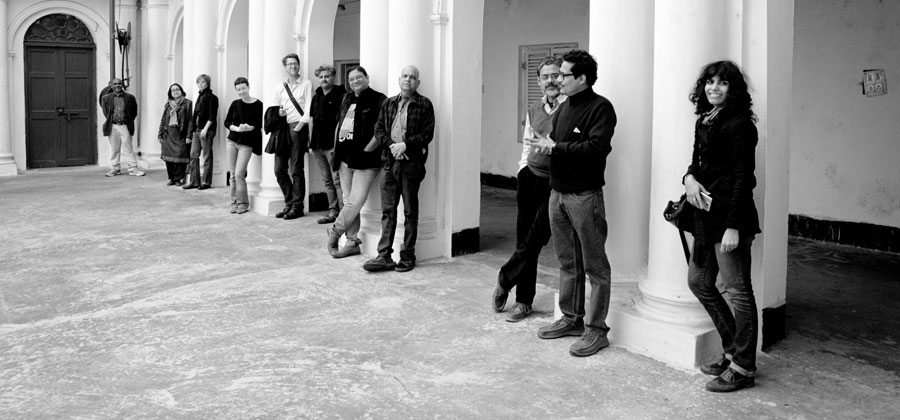
 Photo: Goethe-Institut / Soumya Sankar Bose
Photo: Goethe-Institut / Soumya Sankar BoseA city that 'radically changed’“ Günter Grass, played host to two more German poets this January. Along with Bengali and Odia poets in attendance, the Kolkata arm of the Poets Translating Poets project tested many assumed boundaries, writes Rashmi Dhanwani.
For celebrated German poet, Jan Wagner, an e-mail from Literateurwerkstatt in Berlin inviting him to participate in the Poets Translation Poets encounter in Kolkata, was a “childhood fantasy come true”. Perhaps it was Günter Grass, or perhaps another cultural connect, but Jan was elated. This wasn’t meant to be a usual encounter with two unconnected cultures – this was slowly nudging a new culture, to find one’s home in its nooks. A warm familiarity of patterns, a surprise conundrum of differences, all of which was articulated from within the alcove of mutual trust and respect between the poets.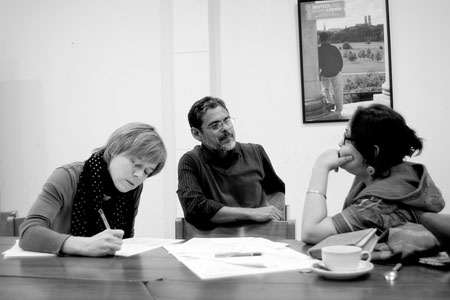 Photo: Goethe-Institut / Soumya Sankar Bose
Photo: Goethe-Institut / Soumya Sankar BoseThey all came from distinct backgrounds and imaginations. German poet Anja Utler is from Regensburg and Vienna, where she lives and works. Yashodhara is an IAS officer, a government service woman who juggles numbers with words (“I write poetry early in the mornings, and late at night when I come back from work.”) Jan Wagner lives and works in Berlin, and is a poet, freelance writer, editor and translator from English and American English. Celebrated for his poetry in Germany, Jan has won the Leipzig Buchmesse Prize (Preis der Leipziger Buchmesse,) in the fiction writing category for his volume of poetry, Regentonnenvariationen. It was the first time that this kind of poetic work was given such an award. Basudev Sunani comes from the remote village of Maniguda, in the district of Nuapada, Odisha (also known as Orissa), and represents a strong, articulate and engaged Dalit presence in the world of Odia verse. Kedar Mishra, our second Odia participant is a renowned contemporary Odia poet and journalist, who writes on a wide range of subjects, from politics to classical dance and music. A student of Bengali and Comparative Literature Sumanta Mukhopadhyay is a poet and teacher by profession. His poems concentrate on a language of silence which addresses the agony of his countrymen and his land. They all represented a rich tapestry of emotions and experiences that was brought into context by the three interlinear translators.
Kolkata-based interlinear translator Partha Chattopadhyay also heads the Goethe-Institut library in the city. He came with some experience of the PTP project as he had helped translate the poems of German poet Hendrik Jackson, and Bangla poets Sajjad Sharif and Shahnaz Munni in Dhaka for the second encounter in Bangladesh. Subroto Saha is a German language teacher and trainer at Goethe-Institut Kolkata, while Dusmanta Chakra teaches the language to students in the Goethe-Institut Pune.
Together, they embarked on five intense days encompassing walks down the Hoogly, visiting the Kali temple, book shopping at Kolkata’s famous College Street, experiencing the adda culture at India Coffee House and culminating into an intimate reading of their poems at the Tata Steel Kolkata Literary Meet at the pebble-lined, majestic Victoria Memorial Quadrangle. Lightly touched upon by unusual connections, the poets came closer.
Parsing the past
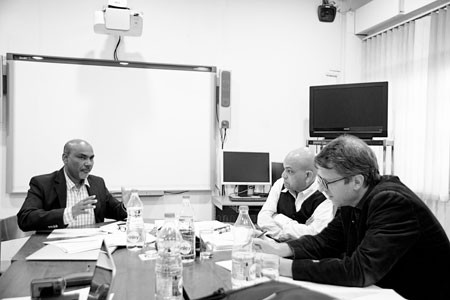 Photo: Goethe-Institut / Soumya Sankar Bose
Photo: Goethe-Institut / Soumya Sankar BoseOn the first day, the poets and translators met and introduced themselves to each other. They then proceeded to recite their poems -- "a very important part of the process for the poets" (explained Partha) as this was their first entry into a foreign language. As Anja explained to me later in the evening, "With most translations I have done so far, I could at least understand the script and get a sense of other elements like onomatopoeia. Here, I didn't even understand what a Bengali or Odia alphabet meant." And here is where other connections made for meaningful contexts, one of which was myths and epics.
Mythology is age old wisdom, narrativised. It creates an engorged pool of life lessons cloaked in a story – sometimes used to express the contemporary. In the Kolkata workshop, history was used to reflect the conundrums of the modern age. Anja used the ancient Greek myth of nymph Daphne and the powerful god Apollo. Daphne, being pursued by Apollo, seeks help from her father, the river god Landon, who turns her into a laurel tree. Anja’s poem questions his actions, which to her is an act of punishment and not a cause of celebration. She uses myth to talk about contemporary choices, and proffers the lens of a woman’s perspective. Much like Sumanta, who drew inspiration from Mahabharata in two of his poems titled Dharma and Mahabharat, Basudev brought in images of Odia folk narratives, stories that are often ignored in a mainstream Indian narrative, overwhelmed by the epics Ramayana and Mahabharata.
The idioms, stories and word evoke the musicians, the gods, the folk heroes, to make sense of the present; sometimes, lightly touching the past like a tangent on the circle of time. As Kedar found a whiff of that in Anja’s Daphne. “Our Odia story of Chandrabhaga by Kabibara Radhanath Ray has a similar plotline,” he explained. It is one of the many legends connected to the magnificent Sun Temple of Konark.
How the poets approach translations
Using some of these myth/epic contexts as building blocks, asking questions, and creating one’s own translation path, each poet exhibited a method to her/ his madness. For Sumanta, a poem "must sound like a poem first". So he preferred to look at the 'versification', rhyme scheme, ground structure. “I want to see where the poem jumps, where the emphases are and where the stresses lie.” Sumanta felt that this (stress, emphasis) was one of the key differences between poetry from Germany – Indian poetry that tends to be time bound as opposed to one that relies on stresses and emphases. "If you want to catch the pulse of the poem, you must go into the verse – to get into the poet's mind, what elevates him, what initiates him into the poem," he explained.
Kedar, on the other hand, proffered a different approach of finding each poem’s “access points”. While he felt that Jan’s poems were easy to understand, Anja's poems were not. “But Anja’s poem is melodious, containing a hidden raag,” which is what helped Kedar access her work. An observation, not far from that of Alexander Gumz, who in a 2004 article wrote of Anja’s poetry as, “a precise notation between score and reading text, language and music. Semantics, syntax and rhythm form a unique unity.” Kedar contrasted her work with that of Basudev's poetry which is modern, in the sense of anti-romantic, and non-musical, leading to an interesting challenge at play. "It took Anja four hours to translate one of Basudev’s poems,” he observed.
Kedar used this learning to hone his own approach to the translation process. He looks at the similarities and differences between the new poem and his own context, he then adds cultural contexts, and geographical dynamics while translating. There is a small part which cannot be translated entirely as it isn’t his original poem in the first place. “There will be transmission loss in that process, but it's my job to ensure to minimise that transmission loss," Kedar conceded. It’s also a process that Basudev exhorts. His greatest challenge in the translation encounter stemmed from finding the right words, which for him is the root of and solution for all translation conundrums.
“Shabd agar siddha ho gayi, toh kabita ban jati hai. Kabita siddha ho gayi, toh mantra ban jata hai (The use of the perfect word makes for enlightened poetry, and the use of the perfect, enlightened poetry makes a mantra),” he philosophised.
Yashodhara, on the other hand, worked with a smaller pool as she had only translated the one long poem by Anja. She found her poem to be challenging, and didn't immediately find an entry point owing to the grammatical and punctuation choices made by the poet. She explained, "Punctuation loses its original meaning in Anja's poems as she uses it to mean something else. She is constantly breaking rules of a language that I don't even know. So I have to translate her language and her own challenges to her language.” This was a long process – it was only on the third day of the workshop that she could get under the skin of Anja's poem and make the right connections.
For Anja and Jan, they were most taken in by the vastly different contexts, languages and styles they encountered. They had to rely chiefly on sound and language structures – “how they form their sentences,” explained Anja. Jan spoke of a choice that a translator needs to make: “Are you bringing the poem to the reader or the reader to the poem? For me, it’s bringing a poem to a poem,” he stated. He acknowledged that in spite of the vast academic literature on the problems and challenges of translations, fundamental problems remain. “You are freer and yet never more bound to what the poet wants to say. It’s a double edged sword. Being bound by total strangeness and familiarity – it creates an interesting tension,” he concluded.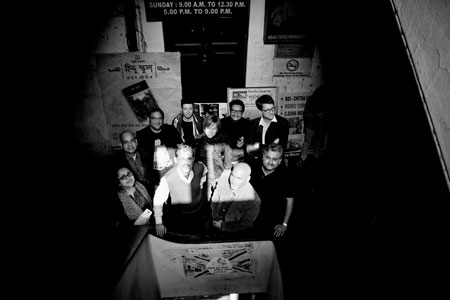 Photo: Goethe-Institut / Soumya Sankar Bose
Photo: Goethe-Institut / Soumya Sankar Bose
The poets and translators were equally affected by the question zones created around their work. For Yashodhara, this was a chance to look afresh at and reflect on her words and the choices she made in her poems from a few years ago. "I am beginning to see why I used the words that I did, and the connections that I drew to make the poem. It's like revisiting your own poem as a guest." Both Yashodhara and Basudev were being translated in this fashion for the first time.
In this mix of those with prior experience of such a process and those with little exposure to translation workshop dynamics, were also the interlinear translators. Subroto, for instance, regularly translates many German poets into Bengali, including the more contemporary poets such as Ulf Stolterfohrt and Tom Schulz. Most of these translations occur over e-mail exchanges with the said poets, unlike this encounter where he had the opportunity to directly ask questions to the poet. Moreover, it’s the questions asked by other poets of each other which helped him look at the process anew. “The translating poets’ questions have helped me ask questions in a different way. Poets look at the translating exercise very differently from traditional translators,” he explained, in a way exhorting the crucial role of the translator in establishing good practices in translation with the creative liberties often afforded by poets themselves in such a process.
Sumanta, on the other hand, found the process of being translated to be rather stretched. "Sometimes I felt I was killing my poem," he joked. But he also spoke about the connections he made - "I touched a thousand miles in one poem. When Jan got my poem - he got me".
This is something Kedar agreed with. One morning, a few of our poets, minus Kedar, went for a walk by the Ganges. Kedar, explaining his absence to Jan later, said that he has an equally beautiful river back home by whose banks he often walks – one that brings two rivers together (referring to the Mahanadi that gets two tributaries into one basin. To which Jan replied, "Oh, I know that river. I saw it in your poem." Kedar was overjoyed at being "understood" in spite of vast cultural differences, and being able to carry his world to another world – his river to another’s imagination.
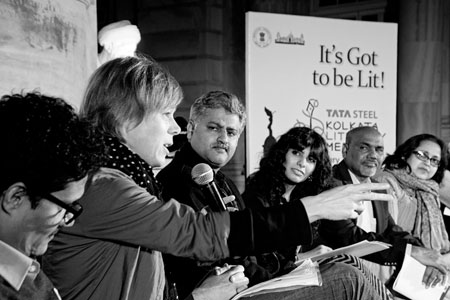 Photo: Goethe-Institut / Soumya Sankar Bose
Photo: Goethe-Institut / Soumya Sankar Bose
On the last evening, at the majestic Victoria Memorial Quadrangle, against the setting Sun foregrounded by the Grecian pillars, the poets sat and read their translations. Yet another world rose around them, of myriad imaginations and emotions – in a journey or roots, meanings and mantras.
Kedar used this learning to hone his own approach to the translation process. He looks at the similarities and differences between the new poem and his own context, he then adds cultural contexts, and geographical dynamics while translating. There is a small part which cannot be translated entirely as it isn’t his original poem in the first place. “There will be transmission loss in that process, but it's my job to ensure to minimise that transmission loss," Kedar conceded. It’s also a process that Basudev exhorts. His greatest challenge in the translation encounter stemmed from finding the right words, which for him is the root of and solution for all translation conundrums.
“Shabd agar siddha ho gayi, toh kabita ban jati hai. Kabita siddha ho gayi, toh mantra ban jata hai (The use of the perfect word makes for enlightened poetry, and the use of the perfect, enlightened poetry makes a mantra),” he philosophised.
Yashodhara, on the other hand, worked with a smaller pool as she had only translated the one long poem by Anja. She found her poem to be challenging, and didn't immediately find an entry point owing to the grammatical and punctuation choices made by the poet. She explained, "Punctuation loses its original meaning in Anja's poems as she uses it to mean something else. She is constantly breaking rules of a language that I don't even know. So I have to translate her language and her own challenges to her language.” This was a long process – it was only on the third day of the workshop that she could get under the skin of Anja's poem and make the right connections.
For Anja and Jan, they were most taken in by the vastly different contexts, languages and styles they encountered. They had to rely chiefly on sound and language structures – “how they form their sentences,” explained Anja. Jan spoke of a choice that a translator needs to make: “Are you bringing the poem to the reader or the reader to the poem? For me, it’s bringing a poem to a poem,” he stated. He acknowledged that in spite of the vast academic literature on the problems and challenges of translations, fundamental problems remain. “You are freer and yet never more bound to what the poet wants to say. It’s a double edged sword. Being bound by total strangeness and familiarity – it creates an interesting tension,” he concluded.
On being translated
 Photo: Goethe-Institut / Soumya Sankar Bose
Photo: Goethe-Institut / Soumya Sankar BoseThe poets and translators were equally affected by the question zones created around their work. For Yashodhara, this was a chance to look afresh at and reflect on her words and the choices she made in her poems from a few years ago. "I am beginning to see why I used the words that I did, and the connections that I drew to make the poem. It's like revisiting your own poem as a guest." Both Yashodhara and Basudev were being translated in this fashion for the first time.
In this mix of those with prior experience of such a process and those with little exposure to translation workshop dynamics, were also the interlinear translators. Subroto, for instance, regularly translates many German poets into Bengali, including the more contemporary poets such as Ulf Stolterfohrt and Tom Schulz. Most of these translations occur over e-mail exchanges with the said poets, unlike this encounter where he had the opportunity to directly ask questions to the poet. Moreover, it’s the questions asked by other poets of each other which helped him look at the process anew. “The translating poets’ questions have helped me ask questions in a different way. Poets look at the translating exercise very differently from traditional translators,” he explained, in a way exhorting the crucial role of the translator in establishing good practices in translation with the creative liberties often afforded by poets themselves in such a process.
Sumanta, on the other hand, found the process of being translated to be rather stretched. "Sometimes I felt I was killing my poem," he joked. But he also spoke about the connections he made - "I touched a thousand miles in one poem. When Jan got my poem - he got me".
This is something Kedar agreed with. One morning, a few of our poets, minus Kedar, went for a walk by the Ganges. Kedar, explaining his absence to Jan later, said that he has an equally beautiful river back home by whose banks he often walks – one that brings two rivers together (referring to the Mahanadi that gets two tributaries into one basin. To which Jan replied, "Oh, I know that river. I saw it in your poem." Kedar was overjoyed at being "understood" in spite of vast cultural differences, and being able to carry his world to another world – his river to another’s imagination.
 Photo: Goethe-Institut / Soumya Sankar Bose
Photo: Goethe-Institut / Soumya Sankar BoseOn the last evening, at the majestic Victoria Memorial Quadrangle, against the setting Sun foregrounded by the Grecian pillars, the poets sat and read their translations. Yet another world rose around them, of myriad imaginations and emotions – in a journey or roots, meanings and mantras.
Rashmi Dhanwani



